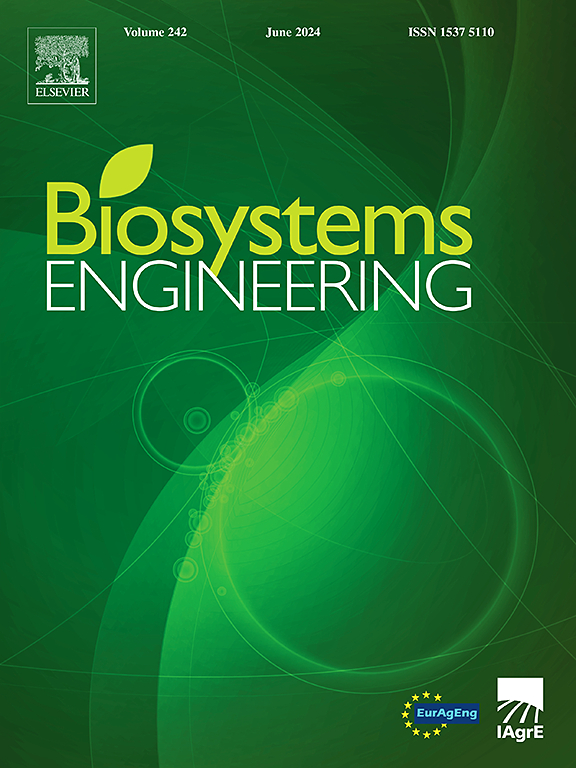Unveiling host-seeking behaviour in entomopathogenic nematodes via lab-on-a-chip technology
IF 5.3
1区 农林科学
Q1 AGRICULTURAL ENGINEERING
引用次数: 0
Abstract
Entomopathogenic nematodes (EPNs) can be employed as biological control agents (BCAs) for many insect pests’ sustainable management. Despite their widespread use, our understanding of EPNs biology, particularly interactions with their hosts, remains limited. Advancing knowledge of EPNs ecology and host interactions is crucial for optimising their efficacy in pest management. This study pioneers an interdisciplinary approach, at the interface of engineering and applied entomology, to investigate the behaviour of the EPN Steinernema carpocapsae. A novel method combining microfluidics, machine learning, and optical flow is presented. A lab-on-a-chip platform was designed to enable accurate investigation of EPN response to stimuli. A convolutional neural network (CNN) identified nematodes and distinguished their responses to host-derived cues achieving 0.94 accuracy and 1.00 precision in detecting stimulus presence at video-level, classifying EPN behaviour within a controlled environment that simulates host conditions. Optical flow analysis revealed differences in motor activity of EPN upon exposure to stimuli, providing new insights into their dynamic responses. Steinernema carpocapsae exhibited more intense activity in presence of host-borne cues (p = 0.0055). Support vector machine (SVM) and multilayer perceptron (MLP) classifiers distinguished stimulus contexts from optical flow features, with an area under the receiver operating characteristic (ROC) curve of 0.71. These results highlight that, although S. carpocapsae is typically considered an ambusher, it may actively engage in host-seeking behaviour, suggesting a shift in our understanding of its search strategies. This methodology significantly enhances the detection and understanding of EPN responses to cues, advancing their potential in precision biocontrol programs for sustainable pest management actions.
Science4Impact statement (S4IS)
This study develops a novel lab-on-a-chip platform integrating artificial intelligence (AI) for the precise investigation of host-seeking behaviours in the entomopathogenic nematode Steinernema carpocapsae, a biological control agent (BCA) with potential for sustainable pest management. By combining microfluidic design with deep learning, the platform accurately assesses nematode responses to host-derived cues, providing new insights into its foraging adaptability beyond conventional techniques. This research can help researchers and agricultural stakeholders by enhancing understanding of BCA behaviour, optimising pest control applications, and informing evidence-based decisions on sustainable crop protection. The findings also support quality assurance in biological control validation by offering a rigorous framework for evaluating nematode effectiveness under realistic conditions, promoting its broader adoption in integrated pest management strategies.
通过芯片实验室技术揭示昆虫病原线虫的寻宿主行为
昆虫病原线虫(EPNs)可作为生物防治剂(bca)用于多种害虫的可持续治理。尽管它们被广泛使用,但我们对epn生物学的理解,特别是与宿主的相互作用,仍然有限。推进EPNs生态学和宿主相互作用的知识对于优化其害虫管理功效至关重要。这项研究开创了一种跨学科的方法,在工程和应用昆虫学的界面上,研究EPN steinerma carpocapsae的行为。提出了一种结合微流体、机器学习和光流的新方法。设计了一个芯片实验室平台,以便准确研究EPN对刺激的反应。卷积神经网络(CNN)识别了线虫,并区分了它们对宿主衍生线索的反应,在视频水平上检测刺激存在的准确率为0.94,精度为1.00,在模拟宿主条件的受控环境中对EPN行为进行了分类。光流分析揭示了EPN在暴露于刺激时运动活动的差异,为其动态反应提供了新的见解。carpocapsae在宿主提示下表现出更强的活性(p = 0.0055)。支持向量机(SVM)和多层感知器(MLP)分类器将刺激上下文和光流特征区分开来,接受者工作特征(ROC)曲线下面积为0.71。这些结果强调,尽管S. carpocapsae通常被认为是一个伏击者,但它可能积极参与寻找宿主的行为,这表明我们对其搜索策略的理解发生了转变。该方法显著提高了EPN对线索反应的检测和理解,提高了它们在可持续害虫管理行动的精确生物防治计划中的潜力。本研究开发了一种集成人工智能(AI)的新型芯片实验室平台,用于精确研究昆虫病原线虫steinerma carpocapsae的寻宿主行为,这是一种具有可持续害虫管理潜力的生物防治剂(BCA)。通过将微流体设计与深度学习相结合,该平台可以准确评估线虫对宿主衍生线索的反应,为其觅食适应性提供超越传统技术的新见解。这项研究可以通过加强对BCA行为的理解、优化病虫害防治应用以及为可持续作物保护的循证决策提供信息,从而帮助研究人员和农业利益相关者。这些发现还通过提供一个严格的框架来评估现实条件下线虫的有效性,从而支持生物防治验证的质量保证,促进其在害虫综合治理战略中的更广泛采用。
本文章由计算机程序翻译,如有差异,请以英文原文为准。
求助全文
约1分钟内获得全文
求助全文
来源期刊

Biosystems Engineering
农林科学-农业工程
CiteScore
10.60
自引率
7.80%
发文量
239
审稿时长
53 days
期刊介绍:
Biosystems Engineering publishes research in engineering and the physical sciences that represent advances in understanding or modelling of the performance of biological systems for sustainable developments in land use and the environment, agriculture and amenity, bioproduction processes and the food chain. The subject matter of the journal reflects the wide range and interdisciplinary nature of research in engineering for biological systems.
 求助内容:
求助内容: 应助结果提醒方式:
应助结果提醒方式:


